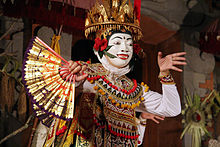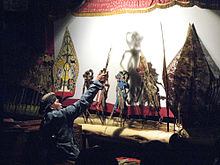- Native Indonesians
-
Native Indonesians
PribumiTotal population 230 million (2006 estimation)[1] Regions with significant populations Indonesia est 200 million[1] Saudi Arabia 850,000 Netherlands 395,800[citation needed] Singapore est 200,000[citation needed] Taiwan 131,980[citation needed] Hong Kong 102,100 [2] Suriname 90,000 [3] Australia 86.196 [4] United Arab Emirates 75,000 [5] United States 70,000[citation needed] Japan 30,567 [citation needed] South Korea 30,000 [citation needed] Philippines 10,000 [6] Languages Indonesian languages
Religion predominantly Islam, minorities practice Protestantism, Catholicism, Hinduism, Buddhism
Related ethnic groups Austronesian peoples, Papuan people, Negrito, Melanesians
Native Indonesians are also known as Pribumi, literally meaning "sons of the soil", is a term that refers to a population group in Indonesia that shares a similar sociocultural heritage.[1] Translated from inlander in Dutch, the term was first coined by the Dutch colonial administration to lump diverse groups of local inhabitants of Indonesia's archipelago, mostly for social discrimination purposes. During the colonial period, the Dutch instilled a regime of three-level racial separation; the first class race being Europeans, the second class race being the "Foreign Orientals" (Vreemde Oosterlingen) which includes Chinese, Arabs, and Indians, the third class race being the "Inlander" or natives. The system was very similar to South Africa's apartheid, which prohibited inter-racial neighborhoods (wet van wijkenstelsel) and inter-racial interactions were limited by "passenstelsel" laws.
Contents
Pribumi makes up about 95% of Indonesian population.[1] Using Indonesia’s population estimate in 2006, the mix translates to about 230 million people. As an umbrella of similar cultural heritage among about hnic groups in Indonesia, Pribumi culture plays a significant role in shaping the country’s socioeconomic condition.The United States Library of Congress defines Pribumi as:
Literally, an indigene, or native. In the colonial era, the great majority of the population of the archipelago came to regard themselves as indigenous, in contrast to the nonindigenous Dutch and Chinese (and, to a degree, Arab) communities. After independence the distinction persisted, expressed as a dichotomy between elements that were pribumi and those that were not. The distinction has had significant implications for economic development policy—Indonesia: A Country Study, Glossary[7]There are over 300 ethnic groups in Indonesia.[8] 200 million of those are of Native Indonesian ancestry.
The largest ethnic group in Indonesia is the Javanese who make up 41% of the total population. The Javanese are concentrated on the island of Java but millions have migrated to other islands throughout the archipelago.[9] The Sundanese, Malay, and Madurese are the next largest groups in the country.[9] Many ethnic groups, particularly in Kalimantan and Papua, have only hundreds of members. Most of the local languages belong to Austronesian language family, although a significant number, particularly in Papua, speak Papuan languages.
The division and classification of ethnic groups in Indonesia is not rigid and in some case are unclear as the result of migrations, also cultural and lingusitic influences; for example some may agree that Bantenese and Cirebonese are belongs to different ethnic group with their own distinct dialect, however another might consider them as Javanese sub-ethnic, the member of larger Javanese people. The same case also with Baduy people that share soo much similarity with Sundanese people that can be considered as belongs to the same ethnic group. The example of hybrid ethnicity is Betawi people, the result of mixture of different ethnicities in Indonesia also with Arab and Chinese since the era of colonial Batavia (Jakarta).
The proportional populations of Native Indonesians according to the (2009 census) is as follows:
Ethnic groups Population (million) Percentage Main Regions Javanese 86.012 41.7 East Java, Central Java, Lampung Sundanese 31.765 15.4 West Java, Banten, Lampung Malay 8.789 4.1 Sumatra eastern coast, West Kalimantan Madurese 6.807 3.3 Madura island, East Java Batak 6.188 3.0 North Sumatra Bugis 6.000 2.9 South Sulawesi, East Kalimantan Minangkabau 5.569 2.7 West Sumatra, Riau Betawi 5.157 2.5 Jakarta, Banten, West Java Banjarese 4.800 2.3 South Kalimantan, East Kalimantan Bantenese 4.331 2.1 Banten, West Java Acehnese 4.000 1.9 Aceh, Jakarta, West Java Balinese 3.094 1.5 Bali Sasak 3.000 1.4 West Nusa Tenggara Makassarese 2.063 1.0 South Sulawesi Cirebonese 1.856 0.9 West Java, Central Java Physical characteristics
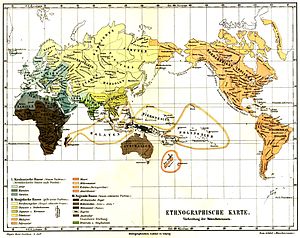 The three great races according to Meyers Konversationslexikon of 1885-90. The subtypes of the Mongoloid race are shown in yellow and orange tones, those of the Europid race in light and medium grayish spring green-cyan tones and those of the Negroid race in brown tones. Dravidians and Sinhalese are in olive green and their classification is described as uncertain. The Mongoloid race sees the widest geographic distribution, including all of the Americas, North Asia, East Asia and Southeast Asia, the entire inhabited Arctic.
The three great races according to Meyers Konversationslexikon of 1885-90. The subtypes of the Mongoloid race are shown in yellow and orange tones, those of the Europid race in light and medium grayish spring green-cyan tones and those of the Negroid race in brown tones. Dravidians and Sinhalese are in olive green and their classification is described as uncertain. The Mongoloid race sees the widest geographic distribution, including all of the Americas, North Asia, East Asia and Southeast Asia, the entire inhabited Arctic.
Native Indonesians skin color ranges from light brown to very dark brown or black, while the Chinese Indonesians have light yellow skin color. Archaeologist Peter Bellwood claims that the "vast majority" of people in Indonesia and Malaysia, the region he calls the "clinal Mongoloid-Australoid zone", are "Southern Mongoloids" but have a "high degree" of Australoid admixture.[10]
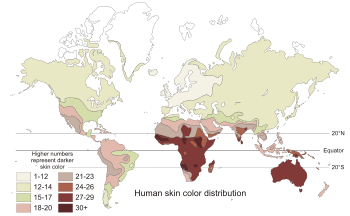 Map of indigenous skin color distribution in the world based on Von Luschan's chromatic scale.
Map of indigenous skin color distribution in the world based on Von Luschan's chromatic scale.
Blumenbach writes:
Malay variety. Tawny-coloured; hair black, soft, curly, thick and plentiful; head moderately narrowed; forehead slightly swelling; nose full, rather wide, as it were diffuse, end thick; mouth large. upper jaw somewhat prominent with the parts of the face when seen in profile, sufficiently prominent and distinct from each other. This last variety includes the islanders of the Pacific Ocean, together with the inhabitants of the Marianne, the Philippine, the Molucca and the Sunda Islands, and of the Malayan peninsula. I wish to call it the Malay, because the majority of the men of this variety, especially those who inhabit the Indian islands close to the Malacca peninsula, as well as the Sandwich, the Society, and the Friendly Islanders, and also the Malambi of Madagascar down to the inhabitants of Easter Island, use the Malay idiom.[11]
Genetic research
Most Native Indonesians are genetically close to Southeast Asians while others show Melanesian affinity. Geneticist Luigi Luca Cavalli-Sforza claims that there is a genetic division between East and Southeast Asians.[12] In a like manner, Zhou Jixu agrees that there is a physical difference between these two populations.[13] Other geneticists have found evidence for four separate populations, carrying distinct sets of non-recombining Y chromosome lineages, within the traditional Mongoloid category: North Asians, Han Chinese, Japanese and Southeast Asians.[14] The complexity of genetic data has led to doubt about the usefulness of the concept of a Mongoloid race itself, since distinctive East Asian features may represent separate lineages and arise from environmental adaptations or retention of common proto-Eurasian ancestral characteristics.[15]
Smaller groups
The regions of Indonesia have some of their indigenous ethnic groups. Due to migration within Indonesia (as part of government transmigration programs or otherwise), there are significant populations of ethic groups who reside outside of their traditional regions.
- Java: Javanese, Sundanese, Bantenese, Betawi, Tengger, Osing, Badui
- Madura: Madurese
- Sumatra: Malays, Batak, Minangkabau, Acehnese, Lampung, Kubu
- Kalimantan: Dayak, Banjar
- Sulawesi: Makassarese, Buginese, Mandar, Minahasa, Gorontalo, Toraja, Bajau
- Lesser Sunda Islands: Balinese, Sasak
- The Moluccas: Nuaulu, Manusela, Wemale
- Papua: Dani, Bauzi, Asmat
Pribumi Worldwide
Malaysia
Malaysia shares a border with Indonesia and both countries share many aspects of their culture, including mutually intelligible national languages. Populations have long moved between the areas which make up the modern-day states. Many people from Sumatra and Sulawesi, which are located in modern-day Indonesia, migrated to the Malay peninsula roughly 700 years ago. In 1300, many Minangkabau people migrated to Malaysia and settled in Negeri Sembilan. In the 18th century, Pagar Ruyung kingdom appointed Raja Melewar as Yamtuan Besar (equivalent to king). In 1402, Parameswara, the Srivijaya prince, migrated to Malay peninsula and founded Sultanate of Malacca. When the Sultanate of Aceh was powerful, the Acehnese people invaded the Malay peninsula a number of times. Nowadays, an estimated 1,500,000 Indonesians in Malaysia, with millions more of Indonesian descent. Tun Abdul Razak, former Malaysian prime minister, is one of many successful politicians originating from Indonesia in Malaysia.[16]
Saudi Arabia
Main article: Indonesians in Saudi ArabiaIndonesian pilgrims have long lived in Hejaz, a region along the west coast of Saudi Arabia. Among them was Ahmad Khatib, who served as the Imam of the Shafi'i school of law at the mosque known as Masjidil Haram, Mecca.[17] Today, most of Indonesians in Saudi Arabia are female domestic workers, with a minority of other types of labour migrants and students. Most of the santri extension studied in Saudi, as well as Al Azhar University in Cairo.
United States
Main article: Indonesian AmericanIn the United States, most Indonesians are students and professional. Boston University and Harvard University are favorite schools for Indonesian people. In the Silicon Valley region of Northern California, there are many professional Indonesian-American engineers in the high-tech industry that are employed in companies such as Cisco Systems, KLA Tencor, Google, Yahoo, Sun Microsystems, and IBM. Sehat Sutardja, CEO of Marvell Technology Group, is one of the success Indonesian professional in USA.[18]
Singapore
Main article: Malays in SingaporeThe Malays in Singapore (Malay: Orang Melayu Singapura) make up about 14% of the country's population. Most of them came from Indonesia. In 19th century, Singapore part of Johor-Riau Sultanate. Many of Indonesian people, mainly Bugis and Minangkabau settled in Singapore. From 1886 till 1890, as many as 21,000 Javanese became bonded labourers with the Singapore Chinese Protectorate, an organisation formed by the British in 1877 to monitor the Chinese population. They performed manual labour in the rubber plantations. After their bond ended, they continued to open up the land and stayed on in Johore. The famous Indonesian descent are, the first president of Singapore Yusof bin Ishak and Zubir Said, who composed the national anthem of Singapore Majulah Singapura.
The Netherlands
Main article: Indo peopleIndonesia was the colonization of the Netherlands. Early 20th century, many Indonesian students studied in the Netherlands. Most of them lived in Leiden and active in Indonesian Vereeniging. During Indonesian National Revolution, many Moluccans migrated to the Netherlands. Most of them were ex KNIL army. In this way around 12,500 persons were settled in the Netherlands. Giovanni Van Bronckhorst, Denny Landzaat, Roy Makaay, Mia Audina, and Daniel Sahuleka are famous people of Indonesian ancestry in the Netherlands.
Australia
Main article: Indonesian AustralianBefore the Dutch and British sailor arrived in Australia. The Indonesian from Southern Sulawesi have been explored Australia northern coast. Each year, the Bugis sailors would sail down on the northwestern monsoon in their wooden pinisi. They would stay in Australia for several months to trade and take tripang (or dried sea cucumber) before returning to Makassar on the dry season off shore winds. These trading voyages continued until 1907.[citation needed]
Suriname
The Indonesian people, mainly Javanese, make up 15% of the population Suriname. In the 19th century, the Dutch sent the Javanese to Suriname as contract workers in plantations. The most famous person of Indonesian descent is Paul Somohardjo as the speaker of the National Assembly of Suriname.[19]
Japan
Main article: Indonesians in JapanHong Kong
Main article: Indonesians in Hong KongSouth Korea
Main article: Indonesians in South KoreaUnited Arab Emirates
Main article: Indonesians in the United Arab EmiratesPhilippines
Main article: Indonesians in the PhilippinesTraditional performing arts
Music
Main article: Music of IndonesiaIndonesia is home to various styles of music, with those from the islands of Java, Sumatra and Bali being frequently recorded. The traditional music of central and East Java and Bali is the gamelan.
On June 29, 1965, Koes Plus, a leading Indonesian pop group in the 1960s, 70s and 80s, was imprisoned in Glodok, West Jakarta, for playing Western-style music. After the resignation of President Sukarno, the law was rescinded, and in the 1970s the Glodok prison was dismantled and replaced with a large shopping mall.
Kroncong is a musical genre that uses guitars and ukuleles as the main musical instruments. This genre had its roots in Portugal and was introduced by Portuguese traders in the fifteenth century. There is a traditional Keroncong Tugu music group in North Jakarta and other traditional Keroncong music groups in Maluku, with strong Portuguese influences. This music genre was popular in the first half of the twentieth century; a contemporary form of Kroncong is called Pop Kroncong.
Angklung musical orchestra, native of West Java, received international recognition as UNESCO has listed the traditional West Java musical instrument made from bamboo in the list of intangible cultural heritage.[20][21]
The soft Sasando music from the province of East Nusa Tenggara in West Timor is completely different. Sasando uses an instrument made from a split leaf of the Lontar palm (Borassus flabellifer), which bears some resemblance to a harp.
Dance
Main article: Dance in IndonesiaIndonesian dance reflects the diversity of culture from ethnic groups that composed the nation of Indonesia. Austronesian roots and Melanesian tribal dance forms are visible, and influences ranging from neighboring Asian countries; such as India, China, and Middle East to European western styles through colonization. Each ethnic group has their own distinct dances; makes total dances in Indonesia are more than 3000 Indonesian original dances. However, the dances of Indonesia can be divided into three eras; the Prehistoric Era, the Hindu/Buddhist Era and the Era of Islam, and into two genres; court dance and folk dance.
There is a continuum in the traditional dances depicting episodes from the Ramayana and Mahabharata from India, ranging through Thailand, all the way to Bali. There is a marked difference, though, between the highly stylized dances of the courts of Yogyakarta and Surakarta and their popular variations. While the court dances are promoted and even performed internationally, the popular forms of dance art and drama must largely be discovered locally.
During the last few years, Saman from Nanggroe Aceh Darussalam has become rather popular and is often portrayed on TV.
Drama and theatre
Wayang, the Javanese, Sundanese, and Balinese shadow puppet theatre shows display several mythological legends such as Ramayana and Mahabharata, and many more. Wayang Orang is Javanese traditional dance drama based on wayang stories. Various Balinese dance drama also can be included within traditional form of Indonesian drama. Another form of local drama is Javanese Ludruk and Ketoprak, Sundanese Sandiwara, and Betawi Lenong. All of these drama incorporated humor and jest, often involving audiences in their performance.
Randai is a folk theatre tradition of the Minangkabau people of West Sumatra, usually performed for traditional ceremonies and festivals. It incorporates music, singing, dance, drama and the silat martial art, with performances often based on semi-historical Minangkabau legends and love story.
Modern performing art also developed in Indonesia with their distinct style of drama. Notable theatre, dance, and drama troupe such as Teater Koma are gain popularity in Indonesia as their drama often portray social and political satire of Indonesian society.
Martial Art
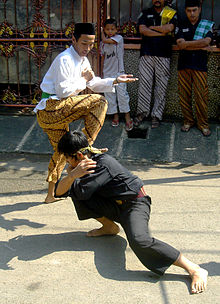 Pencak Silat demonstration in Jakarta.
Pencak Silat demonstration in Jakarta. Main articles: Silat and Pencak Silat
Main articles: Silat and Pencak SilatThe art of silat was created and firstly developed in the islands of Java and Sumatra. It is an art for survival and practiced throughout Indonesian archipelago. Centuries of tribal wars in Indonesian history had shaped silat as it was used by the ancient warriors of Indonesia. Silat was used to determine the rank and position in old Indonesian kingdoms.
Contacts with Indians and Chinese was further enriched silat. Silat reached areas beyond Indonesia mainly through diaspora of Indonesian people. People from various regions like Aceh, Minangkabau, Riau, Bugis, Makassar, Java, Banjar[disambiguation needed
 ], etc. moved into and settled in Malay Peninsula and other islands. They brought silat and passed it down to their descendants. The Indonesian of half-Dutch descent are also credited as the first to brought the art into Europe.
], etc. moved into and settled in Malay Peninsula and other islands. They brought silat and passed it down to their descendants. The Indonesian of half-Dutch descent are also credited as the first to brought the art into Europe.Silat was used by Indonesian freedom fighters during their struggle against the Dutch colonists. Unfortunately after Indonesia achieving their independence, silat became less popular among Indonesian youth compare to foreign martial arts like Karate and Taekwondo. This probably because silat was not taught openly and only passed down among blood relatives, the other reason is the lack of media portrayal of the art.
Efforts have been made in recent years to introduce and reintroduce the beauty of silat to Indonesian youth and the world. Exhibitions and promotions by individuals as well as state-sponsored groups helped the growing of silat's popularity, particularly in Europe and United States. Indonesian 2009 Silat movie Merantau is one of Indonesian efforts to introduce silat to international scene.
Another martial art from Indonesia is Tarung Derajat. It is a modern combat system created by Haji Ahmad Drajat based on his experience as a street fighter. Tarung Drajat has been acknowledge as a national sport by KONI in 1998 and is now using by Indonesian Army as part of their basic training.
See also
- List of Indonesian people
- Arab Indonesian
- Chinese Indonesians
- Bumiputera (Brunei)
- Bumiputera (Malaysia)
- Ethnic groups in Indonesia
- Culture of Indonesia
Notes
- ^ a b c d "Pribumi". Encyclopedia of Modern Asia. Macmillan Reference USA. http://www.bookrags.com/research/pribumi-ema-05/. Retrieved 2006-10-05.
- ^ Media Indonesia Online 2006-11-30
- ^ http://www.joshuaproject.net/peopctry.php
- ^ http://www.abs.gov.au/AUSSTATS/abs@.nsf/webpages/statistics?opendocument
- ^ Expatriates celebrate 64th Indonesian Independence Day in Abu Dhabi - Gulf News
- ^ http://unesdoc.unesco.org/images/0015/001530/153053e.pdf
- ^ The Library of Congress, Federal Research Division. "Glossary -- Indonesia". A Country Study: Indonesia. http://lcweb2.loc.gov/frd/cs/indonesia/id_glos.html. Retrieved 2006-10-04.
- ^ Kuoni - Far East, A world of difference. Page 88. Published 1999 by Kuoni Travel & JPM Publications
- ^ a b Indonesia's Population: Ethnicity and Religion in a Changing Political Landscape. Institute of Southeast Asian Studies. 2003.
- ^ Bellwood, Peter. Pre-History of the Indo-malaysian Archipelago. Australian National University:1985. ISBN 978-1-921313-11-0
- ^ Johann Friedrich Blumenbach, The anthropological treatises of Johann Friedrich Blumenbach, translated by Thomas Bendyshe. 1865. November 2, 2006. [1]
- ^ The Chinese Human Genome Diversity Project, L. Luca Cavalli-Sforza
- ^ http://sino-platonic.org/complete/spp175_chinese_civilization_agriculture.pdf The Rise of Agricultural Civilization in China, Sino-Platonic Papers 175, Zhou Jixu, citing Ho Ping-ti, ISBN 0-226-34524-6
- ^ TAJIMA Atsushi, PAN I.-Hung, FUCHAROEN Goonnapa, FUCHAROEN Supan, MATSUO Masafumi, TOKUNAGA Katsushi, JUJI Takeo, HAYAMI Masanori, OMOTO Keiichi, HORAI Satoshi, "Three major lineages of Asian Y chromosomes: implications for the peopling of east and southeast Asia," Human Genetics 2002, vol. 110, no1, pp. 80-88
- ^ Encyclopedia Britannica, Mongoloid
- ^ [2]
- ^ Ricklefs, M.C. (1994). A History of Modern Indonesia Since c. 1300.
- ^ Meet Marvell Forbes Article
- ^ English Not On Menu For Wednesday's Press Briefing
- ^ UNESCO, Angklung was officially recognized in Nov 18, 2010 at the Fifth Unesco Inter-Governmental Committee meeting on Intangible Cultural Heritage in Nairobi, Kenya.
- ^ UNESCO grants Indonesia's angklung cultural heritage title
Further reading
- Center for Information and Development Studies. (1998) Pribumi dan Non-Pribumi dalam Perspektif Pemerataan Ekonomi dan Integrasi Sosial (Pribumi and Non-Pribumi in the Perspective of Economic Redistribution and Social Integration). Jakarta, Indonesia: Center for Information and Development Studies
- Suryadinata, Leo. (1992) Pribumi Indonesians, the Chinese Minority, and China. Singapore: Heinemann Asia.
Categories:- Indonesian society
Wikimedia Foundation. 2010.




